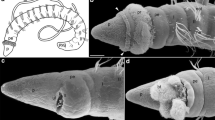Summary
The differentiation of nematocysts and associated structures in the tentacles of the sea anemone Metridium senile fimbriatum and in the tentacles of medusae of the hydroid Obelia longissima was studied by electron microscopy. Stages in the morphogenesis of nematocysts are: 1. transformation of an interstitial cell into a cnidoblast in which the primordium of the nematocyst arises from Golgi vacuoles, 2. development of the basal part of the primordium into a capsular region that is continuous with an external tube with which microtubules, Golgi apparatus, and centrioles are associated distally, 3. growth of the capsular region to include most of the external tube, and 4. differentiation of an internal tube with spines from the matrix of the capsule and of the remaining external tube. The external tube is not invaginated to become the internal tube, but is incorporated into the capsular region by distal growth of the capsular wall. At the same time the matrix, both before and during differentiation into a thread, moves into the capsule. The development of nematocysts in Obelia differs from that in Metridium in several respects. In the former the basitrich has an operculum plus associated cnidocil and dense rods whereas in the latter the nematocysts (amastigophore, b-mastigophore and basitrich) have three apical flaps and an associated flagellum, with the exception of the spirocyst.
Similar content being viewed by others
References
Burgos, M. H., and D. W. Fawcett: Studies on the fine structure of the mammalian testis. I. Differentiation of the spermatids in the cat (Felis domestica). J. biophys. biochem. Cytol. 1, 287–300 (1955).
Byers, B., and K. R. Porter: Oriented microtubules in elongating cells of the developing lens rudiment after induction. Proc. nat. Acad. Sci. (Wash.) 52, 1091–1099 (1964).
Chapman, G. B., and L. G. Tilney: Cytological studies of the nematocysts of hydra. I. Desmonemes, isorhizas, cnidocils, and supporting structures. J. biophys. biochem. Cytol. 5, 69–78 (1959a).
—: Cytological studies of the nematocysts of hydra. II. The stenoteles. J. biophys. biochem. Cytol. 5, 79–84 (1959b).
Dalton, A. J.: A chrome-osmium fixative for electron microscopy. Anat. Rec. 121, 281 (1955).
Eakin, R. M., and J. A. Westfall: Dissection and oriented embedding of small specimens for ultramicrotomy. Stain Technol. 40, 13–14 (1965).
Hovasse, R.: Trichocystes, corps trichocystoïdes, cnidocystes et colloblastes. Protoplasmatologia 3 F, 1–57 (1965).
Hyman, L. H.: The Invertebrates: Protozoa through ctenophora, vol. 1, New York: McGrawHill Book Co. 1940.
Jickeli, C. F.: Der Bau der Hydroidpolypen. I. Über den histologischen Bau von Eudendrium Ehrbg. und Hydra L. Morph. Jb. 8, 373–416 (1883).
Kitching, J. A.: The axopods of the sun animalcule Actinophrys sol (Helizoa). In: Primitive motile systems in cell biology. New York: Academic Press 1964.
Ledbetter, M. C., and K. R. Porter: A “microtubule” in plant cell fine structure. J. Cell Biol. 19, 239–250 (1963).
Lentz, T. L.: The fine structure of differentiating interstitial cells in Hydra. Z. Zellforsch. 67, 547–560 (1965).
Lom, J., and P. De Puytorac: Studies on the myxosporidian ultrastructure and polar capsule development. Protistologica 1, 53–66 (1965).
—, and J. Vávra: Notes on the morphogenesis of the polar filament in Henneguya (protozoa, cnidosporidia). Acta protozool. 3, 57–60 (1965).
Luft, J. H.: Improvements in epoxy resin embedding methods. J. biophys. biochem. Cytol. 9, 409–414 (1961).
Mattern, C. F. T., H. D. Park, and W. A. Daniel: Electron microscope observations on the structure and discharge of the stenotele of hydra. J. Cell Biol. 27, 621–638 (1965).
Möbius, K.: Über den Bau, den Mechanismus und die Entwicklung der Nesselkapseln einiger Polypen und Quallen. Abh. naturwiss. Verein in Hamburg 5, 1–22 (1866).
Reisinger, E.: Das Integument der Coelenteraten, acölomaten und pseudocölomaten Würmer. Studium gen. 17, 125–142 (1964).
Reynolds, E. S.: The use of lead citrate at high pH as an electron-opaque stain in electron microscopy. J. Cell Biol. 17, 208–212 (1963).
Siekevitz, P., and G. E. Palade: A cytochemical study on the pancreas of the guinea pig. III. In vivo incorporation of leucine-l-C14 into proteins of cell fractions. J. biophys. biochem. Cytol. 4, 557–566 (1958).
Silveira, M., and K. R. Porter: The spermatozoids of flatworms and their microtubular systems. Protoplasma (Wien) 59, 240–265 (1964).
Slautterback, D. B.: Nematocyst development. In: The biology of hydra and some other coelenterates. Coral Gables: University Miami Press 1961.
—: Cytoplasmic microtubules. I. Hydra. J. Cell Biol. 18, 367–388 (1963).
—, and D. W. Fawcett: The development of the cnidoblasts of hydra. J. biophys. biochem. Cytol. 5, 441–452 (1959).
Wagner, J.: Recherches sur l'organisation Monobrachium parasiticum Méréjk. Arch. Biol. (Liege) 10, 273–309 (1890).
Watson, M. L.: Staining of tissue sections for electron microscopy with heavy metals. J. biophys. biochem. Cytol. 4, 475–478 (1958).
Weill, R.: Contribution a l'étude des cnidaires et de leurs nématocystes. I. Recherches sur les nématocystes (Morphologie-Physiologie-Developpement). Trav. Stat. Zool. Wimereux. 10, 1–347 (1934).
Westfall, J. A.: Nematocysts of the sea anemone Metridium. Amer. Zool. 5, 377–393 (1965a).
—: The morphology and development of nematocysts and associated structures in the cnidaria. Ph. D. thesis University of California, Berkeley 1965b.
—: Development of nematocysts in the cnidaria. Amer. Zool. 5, 665 (1965c).
Author information
Authors and Affiliations
Additional information
The author is indebted to Professor Richard M. Eakin for valuable criticism and encouragement and to his United States Public Health Service grant for partial support of this study. I acknowledge with appreciation a critical reading of the manuscript by Professors Cadet Hand and Ralph I. Smith.
Rights and permissions
About this article
Cite this article
Westfall, J.A. The differentiation of nematocysts and associated structures in the cnidaria. Zeitschrift für Zellforschung 75, 381–403 (1966). https://doi.org/10.1007/BF00336871
Received:
Issue Date:
DOI: https://doi.org/10.1007/BF00336871




